Apps
Auto Added by WPeMatico
Auto Added by WPeMatico
With the App Store’s big makeover in fall 2017, Apple attempted to shift consumers’ attention away from the Top Charts and more toward editorial content. But app developers still want to make it to the No. 1 position. According to new research from app store intelligence firm Sensor Tower, it’s become easier for non-game apps over the past few years to achieve the top ranking.
Specifically, the firm found that the median number of daily downloads required for non-game applications on the U.S. iPhone App Store to reach No. 1 decreased around 34%, from 136,000 to 90,000 in 2018, then increased a little more than 4% to 94,000 this year.
At the same time, the number of non-game installs on the U.S. App Store had increased by 33% between Q1 2016 and Q1 2019.
These findings, Sensor Tower suggests, indicate that the U.S. market for the top social and messaging apps has become saturated, with downloads for top apps like Facebook and Messenger decreasing over time. In addition, no other apps have found the same level of success that Snapchat and Bitmoji did back in 2016 and 2017, the report adds.
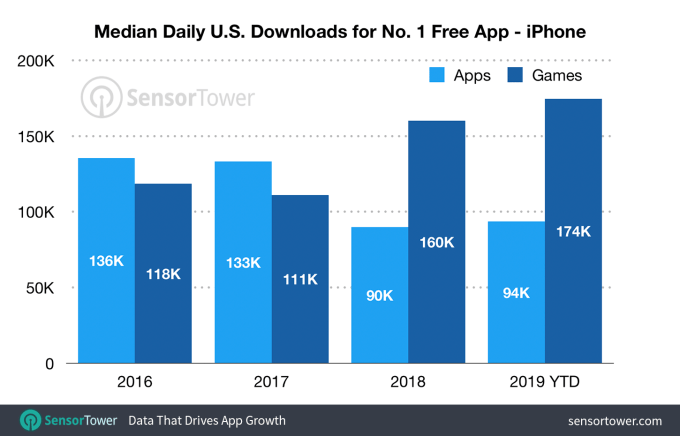
For example, Messenger saw 5 million U.S. App Store installs in November 2016 while Bitmoji and Snapchat passed 5 million installs in August 2016 and March 2017, respectively. And no other non-game app has topped 3.5 million installs in a single month since March 2017.
Meanwhile, the decline in downloads needed to reach the No. 1 spot on Google Play was even more significant.
The median daily downloads for the top non-game app decreased by 65%, from 209,000 in 2016 to 74,000 so far in 2019.
Similarly, the store saw a decrease in installs among top apps, including Messenger, Facebook, Snapchat, Pandora and Instagram. Messenger, for example, saw its yearly installs fall by 68% from nearly 80 million in 2016 to 26 million in 2018.
Games
With mobile games, however, it’s a different story across both app stores.
On the Apple App Store, it has taken 174,000 downloads for a game to reach the top of the rankings on any given day in 2019 — 85% more the 94,000 installs required for non-game app to reach the top of the charts.
This figure also represents an increase of 47% compared to the 118,000 median daily downloads required to top the charts back in 2016, Sensor Tower said.
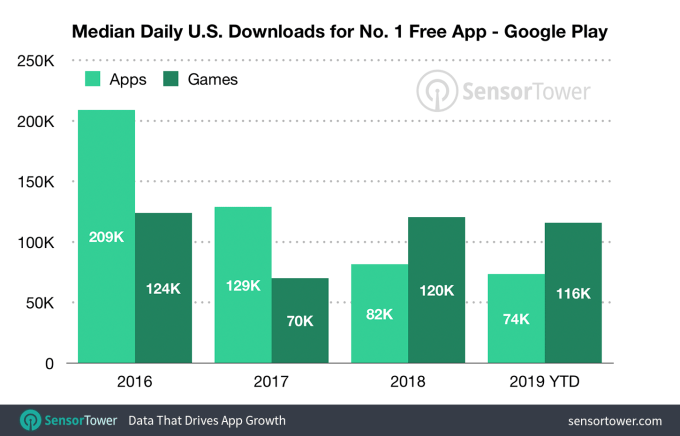
In part, this trend is due to the rise of hyper-casual gaming. So far in 2019, 28 games have reached the No. 1 position on the U.S. App Store, with hyper-casual games making up all but four of those. And of those four, only Harry Potter: Wizards Unite spent more than one day at the top of the charts. Meanwhile, hyper-casual games like aquapark.io and Colorbump 3D have spent 25 and 30 days at No. 1, respectively.
On Google Play, the median daily installs to reach the No. 1 position increased from 70,000 in 2017 to 116,000 so far in 2019, or 66% growth. Overall game downloads, however, decreased 16% from 646 million in Q1 2017 to 544 million in Q1 2019.
Similarly, 21 out of the 23 games that reached the top spot this year have been hyper-casual titles, like Words Story or Traffic Run.
Breaking the top 10
While topping the charts has gotten easier for non-game apps over the years, breaking into the top 10 has gotten more difficult. Median U.S. daily installs for the No. 10 free non-game app increased 11%, from 44,000 in 2016 to 49,000 in 2019.
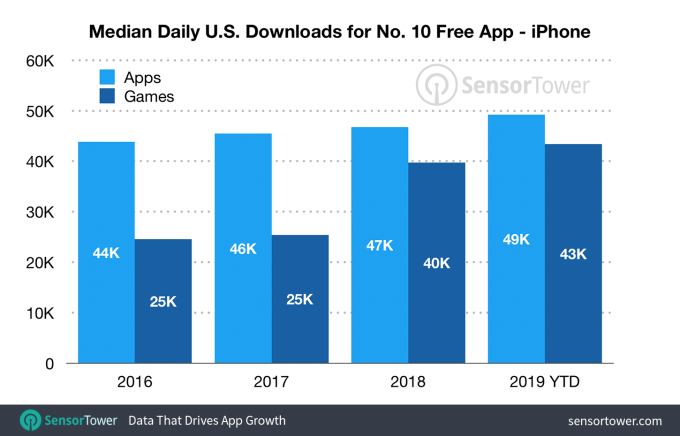
On Google Play, median daily installs for non-game apps fell nearly 50%, from 55,000 median daily installs in 2016 to 31,000 in 2019.
For games, the No. 10 game’s spot on the App Store increased from 25,000 median daily installs in 2016 to 43,000 so far in 2019, and Google Play saw 26% growth, from 27,000 to 34,000 during the same period.
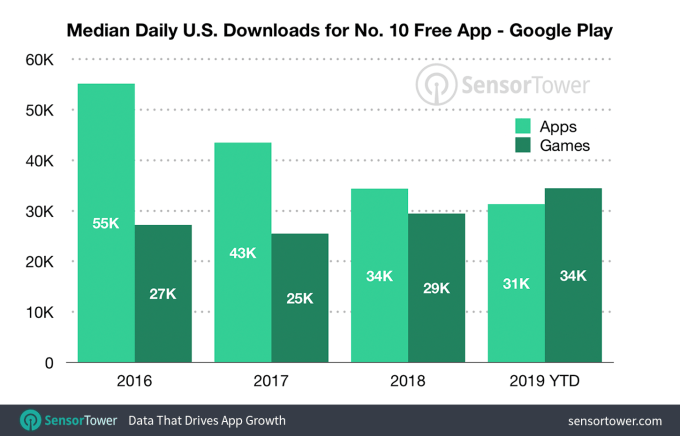
Categories making the Top 10
In terms of breaking into the top 10 by category, Photo & Video apps on the App Store present the most challenge. The category where YouTube, Instagram, TikTok and Snapchat reside saw a median daily amount of more than 16,000 downloads for the No. 10 app.
This was followed by Shopping (15,300 daily downloads for the No. 10 app), Social Networking (14,500), Entertainment (12,600) and Productivity (12,400).
On Google Play, Entertainment apps — like Hulu, Netflix and Bitmoji — need around 17,100 U.S. installs in a day to reach the top 10. This is followed by Shopping (10,800), Social (9,100), Music (8,200) and Finance (8,000).
Beyond the U.S.
Outside the U.S., a non-game app needs approximately 91,000 downloads to reach the top 10 on the App Store in China — higher than the 49,000 installs needed in the U.S. For games, the U.S. is the most difficult to crack the top 10, with a median of 43,000 daily downloads for the No. 10 game.
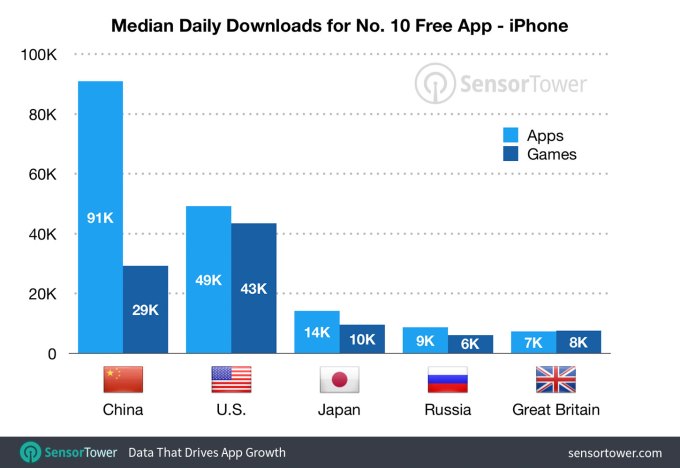
On Google Play, India required the most downloads to reach the top 10, with apps needing 256,000 downloads in a day and games needing 117,000 downloads.
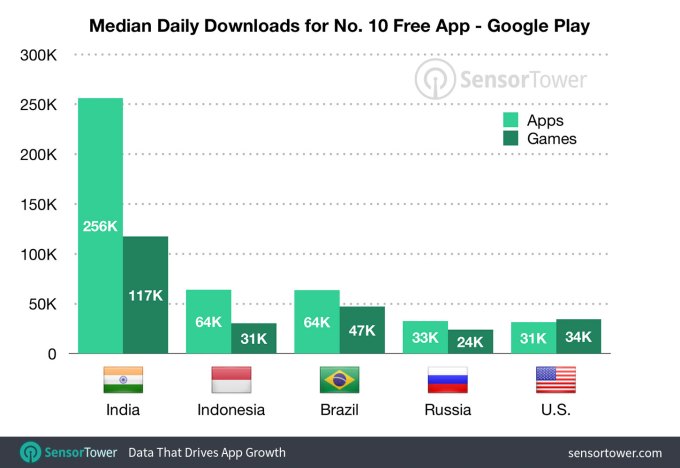
Of course, the App Store’s ranking algorithms — nor Google Play’s algorithms — don’t rely on downloads alone to determine an app’s ranking. Apple takes into consideration downloads and velocity, among other undocumented factors. Google Play does something similar.
But these days, developers are more concerned with showing up highly ranked in app store searches than they are on top charts, where they’ll need to consider numerous other factors beyond downloads — like keywords, description, user engagement and even app quality, among other things.
Powered by WPeMatico
BharatPe, a New Delhi-based firm that is enabling hundreds of thousands of merchants to start accepting digital payments for the first time, and is also giving them access to working capital, has raised $50 million as it looks to scale its business in the nation.
The Series B round for the one-year-old startup was led by San Francisco-headquartered VC firm Ribbit Capital and London-based Steadview Capital, both of which have previously invested in a number of financial services in India.
Existing investors Sequoia Capital, Beenext Capital and Insight Partners also participated in the round, pushing BharatPe’s all-time raise to $65 million. The new round valued the startup at $225 million, Ashneer Grover, co-founder and CEO of BharatPe, told TechCrunch in an interview.
Google and Amazon, both of which offer payment services in India, were also in advanced stages of talks to fund BharatPe’s Series B financing round, but the startup’s founding team was not keen on diluting their stakes, especially in the wake of BharatPe’s recent growth, a person familiar with the matter told TechCrunch.
BharatPe operates an eponymous service to help offline merchants accept digital payments. Even as India has already emerged as the second largest internet market, with more than 500 million users, much of the country remains offline. Among those outside of the reach of the internet are merchants running small businesses, such as roadside tea stalls.
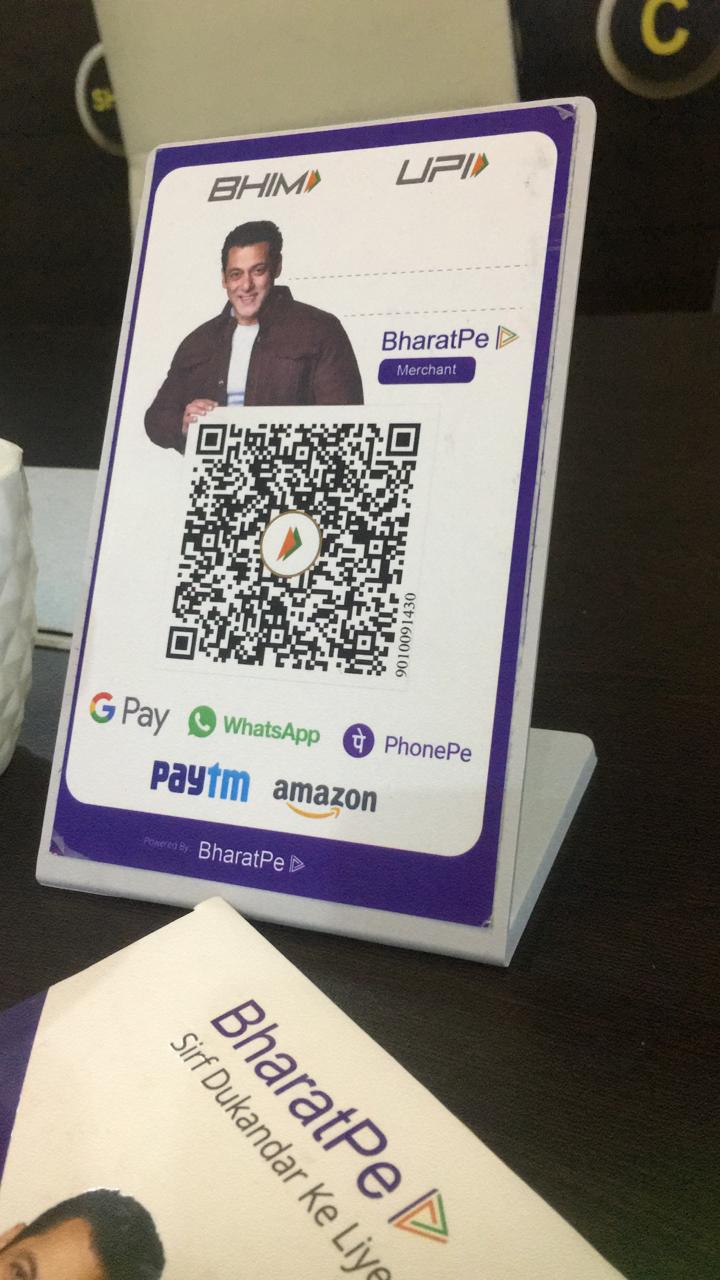
To make these merchants comfortable in accepting digital payments, BharatPe relies on QR codes built as part of government-backed UPI payments infrastructure. “We get them to put up a QR code in their shops, and any customer that uses a UPI-powered payments app — which is now supported by nearly every payments app in India — can pay these shop owners digitally,” said Grover.
Through BharatPe, these merchants also get access to a simplified dashboard on their phones to track the customers who owe them money and get periodic reminders.
BharatPe has amassed more than 1.5 million merchants on its platform. It processes more than 21 million transactions a month, worth more than $83 million, Grover said.
BharatPe also allows merchants to secure short-term loans. New merchants can secure about $500 for a period of three months from BharatPe. As merchants spend more time on BharatPe, the firm increases the amount to about $2,000.
The lending business is crucial to BharatPe. Payment apps make little to no money through making transactions on their platforms. Those processing UPI payments can not even charge a small commission to merchants. “There is no money to be made in doing payments in India,” Grover said. So you charge small interest on loans.
Access to working capital is a major challenge in developed markets such as India. According to a World Bank report, more than 2 billion people globally do not have access to working capital.
Grover said BharatPe aims to use the fund to add about 3.5 million merchants in the next 12 months. The firm has more than 2,000 sales people who are adding 400,000 new merchants to BharatPe each month, he said.
The rest of the money will go into financing the loans on the platform and building new solutions. Later today, BharatPe will launch a new service to connect suppliers and merchants through BharatPe so that their accounts are in sync.
Powered by WPeMatico
Twitter’s ongoing, long-term efforts to make conversations easier to follow and engage with on its platform is getting a boost with the company’s latest acquihire. The company has picked up the team behind Lightwell, a startup that had built a set of developer tools to build interactive, narrative apps, for an undisclosed sum. Lightwell’s founder and CEO, Suzanne Xie, is becoming a director of product leading Twitter’s Conversations initiative, with the rest of her small four-person team joining her on the conversations project.
(Sidenote: Sara Haider, who had been leading the charge on rethinking the design of Conversations on Twitter, most recently through the release of twttr, Twitter’s newish prototyping app, announced that she would be moving on to a new project at the company after a short break. I understand twttr will continue to be used to openly test conversation tweaks and other potential changes to how the app works. )
The Lightwell/Twitter news was announced late yesterday both by Lightwell itself and Twitter’s VP of product Keith Coleman. A Twitter spokesperson also confirmed the deal to TechCrunch in a short statement today: “We are excited to welcome Suzanne and her team to Twitter to help drive forward the important work we are doing to serve the public conversation,” he said. Interestingly, Twitter is on a product hiring push it seems. Other recent hires Coleman noted were Other recent product hires include Angela Wise and Tom Hauburger. Coincidentally, both joined from autonomous companies, respectively Waymo and Voyage.
To be clear, this is more acqui-hire than hire: only the Lightwell team (of what looks like three people) is joining Twitter. The Lightwell product will no longer be developed, but it is not going away, either. Xie noted in a separate Medium post that apps that have already been built (or plan to be built) on the platform will continue to work. It will also now be free to use.
Lightwell originally started life in 2012 as Hullabalu, as one of the many companies producing original-content interactive children’s stories for smartphones and tablets. In a sea of children-focused storybook apps, Hullabalu’s stories stood out not just because of the distinctive cast of characters that the startup had created, but for how the narratives were presented: part book, part interactive game, the stories engaged children and moved narratives along by getting the users to touch and drag elements across the screen.

After some years, Hullabalu saw an opportunity to package its technology and make it available as a platform for all developers, to be used not just by other creators of children’s content, but advertisers and more. It seems the company shifted at that time to make Lightwell its main focus.
The Hullabalu apps remained live on the App Store, even when the company moved on to focus on Lightwell. However, they hadn’t been updated in two years’ time. Xie says they will remain as is.
In its startup life, the company went through YCombinator, TechStars, and picked up some $6.5 million in funding (per Crunchbase), from investors that included Joanne Wilson, SV Angel, Vayner, Spark Labs, Great Oak, Scout Ventures and more.
If turning Hullabalu into Lightwell was a pivot, then the exit to Twitter can be considered yet another interesting shift in how talent and expertise optimized for one end can be repurposed to meet another.
One of Twitter’s biggest challenges over the years has been trying to create a way to make conversations (also narratives of a kind) easy to follow — both for those who are power users, and for those who are not and might otherwise easily be put off from using the product.
The crux of the problem has been that Twitter’s DNA is about real-time rivers of chatter that flow in one single feed, while conversations by their nature linger around a specific topic and become hard to follow when there are too many people talking. Trying to build a way to fit the two concepts together has foxed the company for a long time now.
At its best, bringing in a new team from the outside will potentially give Twitter a fresh perspective on how to approach conversations on the platform, and the fact that Lightwell has been thinking about creative ways to present narratives gives them some cred as a group that might come up completely new concepts for presenting conversations.
At a time when it seems that the conversation around Conversations had somewhat stagnated, it’s good to see a new chapter opening up.
Powered by WPeMatico
Multiple reports this week claimed Google had quietly rolled out a more in-depth app review process to all developers — changes designed to keep the Play Store safer from spam, malware and copycat apps. Those reports are inaccurate, Google tells TechCrunch. Instead, the company is giving itself more time to review apps from new, unestablished developers on the Play Store, as previously announced, but this hasn’t been extended to all developers.
Concerns about these so-called “unannounced changes” stemmed from a blog post by Choice of Games, which wrote that “all new apps” would be getting an additional review, slowing down app approvals. It claimed new apps would require at least three days for review, and this now included existing developers.
The post cited a conversation with Google Support as the source for its claims.
This led to a ton of confusion, as the development shop behind the post was well-established, having been on the Play Store since 2010 and would have been exempt from Google’s policy of increased reviews for new developers.
As it turns out, it appears there was miscommunication between Google Play Store developer support and the developer, according to the chat transcript that was published. The support person, “Liz,” was alerting the developer to the new policy Google announced in April, which detailed increased review times for Play Store newcomers. She didn’t appear to understand that she was speaking with a developer who had published on Google Play for nearly a decade.
Android Police also picked up the news, writing that Google had “quietly instigated a more involved review process that impacts every app and update.”
Reddit and Hacker News also weighed in. In addition to the reported changes, developers were concerned there was now no way to schedule new app releases through the Timed Publishing feature. (That’s also not true — developers can publish to a closed testing track, then use Timed Publishing to go live to the public.)
A Google Developer Relations team member stepped in to clear things up on Reddit, and we’ve confirmed with Google that his responses were accurate.
Google’s updated app review process, first announced in April, hasn’t changed.
At the time, Google said:
“We will soon be taking more time (days, not weeks) to review apps by developers that don’t yet have a track record with us. This will allow us to do more thorough checks before approving apps to go live in the store and will help us make even fewer inaccurate decisions on developer accounts.”
Google began notifying developers directly in the Play Console in June that new apps by developers without a track record will take a couple of days longer to review. Google says that, since this change, it’s already seen a meaningful increase in the number of harmful apps blocked by Play even before they are published.
It’s not clear why the developer relations support person miscommunicated this information to the developer in question, but it points to a training issue on Google’s part.
It’s also unclear why the established developer’s app was held up in app review, beyond it just being a mistake on Google’s part.
Unfortunately for Google, Play Store developers have come to expect a speedy review process, so any delays feel like unnecessary friction.
Unlike Apple, which employs a large team to carefully review app submissions and make hard calls on controversial apps, Google has more heavily relied on automation over the years. The company disclosed in the past how it uses software to pre-analyze apps for viruses, malware and other content and copyright violations.
That process doesn’t always work, though. Only days ago, dozens of Android apps disguised as harmless photo editors and games were discovered to actually be adware. This follows similar news from January, when 85 apps were found to contain adware… and in May, when adware was discovered in some 200 apps totaling 150+ million installs… and, news from last November, when malware was found across more than a dozen apps with half a million installs… and so on.
While it would make sense for Google to increase its review of all apps, given its inability to address this problem, that was not the case here.
Powered by WPeMatico
Tala, a Santa Monica, Calif.-headquartered startup that creates a credit profile to provide uncollateralized loans to millions of people in emerging markets, has raised $110 million in a new financing round to enter India’s burgeoning fintech space.
The Series D financing for the five-year-old startup was led by RPS Ventures, with GGV Capital and previous investors IVP, Revolution Growth, Lowercase Capital, Data Collective VC, ThomVest Ventures and PayPal Ventures also participating in the round.
The new round, which takes the startup’s total fundraising to more than $215 million, valued it above $750 million, a person familiar with the matter told TechCrunch. Tala has also raised an additional $100 million in debt, including a $50 million facility led by Colchis in the last year.
Tala looks at a customer’s texts and calls logs, merchant transactions, overall app usage and other behavioral data through its Android app to build their credit profile. Based on these pieces of information, its machine learning algorithms evaluate the individual risk and provide instant loans in the range of $10 to $500 to customers.
This model is different from how banks and most other online lenders assess a person’s eligibility for a loan. Banks look at a user’s credit score while most online lenders check the financial history.
Tala is also much faster. It approves loans within minutes and disburses the money via mobile payment platforms. The startup has lent over $1 billion to more than 4 million customers to date — up from issuing $300 million in loans to 1.3 million customers last year, Shivani Siroya, founder and CEO of Tala, told TechCrunch in an interview.
The startup, which employs more than 550 people, will use the new capital to enter India, said Siroya, who built Tala after interviewing thousands of small and micro-businesses.
In the run up to launch in India, Tala began a 12-month pilot program in the country last year to conduct user research and understand the market. It has also set up a technology hub in Bangalore, she said.

Shivani Siroya (Tala CEO) at TechCrunch Disrupt NY 2017
“The opportunity is very massive in India, so we spent some time customizing our service for the local market,” she said.
According to World Bank, more than 2 billion people globally have limited access to financial services and working capital. For these people, many of whom live in India, securing a small size loan is extremely challenging as they don’t have a credit score.
In recent years, several major digital payment platforms in India, including Paytm and MobiKwik, have started to offer small-sized loans to users. Traditional banks are still lagging to serve this segment, industry executives say. (Outside India, Tala competes with Branch, a five-year-old San Francisco-based startup that has raised more than $170 million to date and earlier this year inked a deal with Visa.)
Tala goes a step further and takes liability for any unpaid returns, Siroya said. More than 90% of Tala users pay back their loan in 20 to 30 days and are recurring customers, she added.
The startup also forwards the positive credit history and rankings to the local credit bureaus to help people secure bigger and long-term loans in the future, she added.
Tala, which charges a one-time fee that is as low as 5% for each loan, relies on referrals, and some marketing through radio and television to acquire new customers. “But a lot of these users come because they heard about us from their friends,” Siryoa said.
As part of the new financing round, Kabir Misra, founding general partner of RPS Ventures, has joined Tala’s board of directors, the startup said.
Tala said it will use a portion of its new fund to expand its footprint and team in its existing markets — East Africa, Mexico and the Philippines — and also build new solutions.
Siroya said the startup has identified some more markets that it wishes to serve. She did not disclose the names, but said she is eyeing more countries in South Asia and Latin America.
Powered by WPeMatico
The process of using the Stoic journaling app is simple: You open the app in the morning and the evening, when you’ll be prompted to answer a couple of questions and perform a few simple exercises.
For example, this evening the app asked me to rate my current level of fulfillment and to identify what made me smile today, while also pointing me to guided exercises like journaling and breathing.
Stoic is part of the current batch of startups at Y Combinator (it’s taking the stage today at Demo Day). Founder Maciej Lobodzinski told me that his goal is to help users understand the different factors influencing their mental and emotional state.
“The core of the app is: We have this insight and we see what influences your mood and what you feel,” Lobodzinski said. He suggested that this is very different from the “super transactional” idea embedded in my other mental health and wellness apps, where “you pay for my app and you feel better.” In his view, “You should feel how you feel. It’s okay, how you feel, but you should know why you are feeling this way.”
So once there are a couple of weeks of data in the app, you should be able to look back and see how you were feeling on a certain day, and if there were activities that made you feel more or less fulfilled. Over time, Lobodzinski hopes to add more insights about “what influenced you, why you feel this way, why you are productive.”
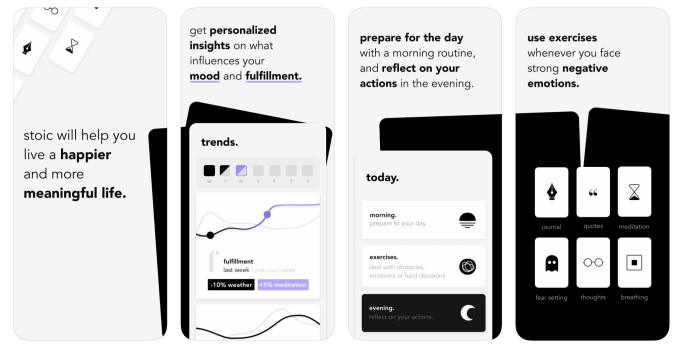
As the name implies, Stoic is inspired by Lobodzinski’s interest in classical Stoic philosophy (he’s not the first to suggest that the approach has direct applications in the tech industry), and the app even includes quotes from Stoic philosophers.
“It’s an extremely practical framework,” he said. “When I talk to users, there are entrepreneurs, investors, traders — people who found out about the app because they were looking for how to deal with their stress …
If you are stressed with your everyday life and you can get the advice of the emperor of Rome, who dealt with much more serious things, it’s amazing how much better you can feel after that.”
At the same time, users have the option to receive quotes from different schools of thought — not just Stoicism but also Buddhism, Taoism and Catholicism. For some users, their app experience won’t be explicitly focused on Stoicism, but Lobodzinski said that even then, it forms the “spine” of the app’s approach.
The basic app is free, but Stoic charges $27.99 per year for a premium version that includes iCloud syncing and additional content.
Powered by WPeMatico
The chat fiction stories offered in Mammoth Media‘s mobile app Yarn are about to get more interactive.
The branching narrative mechanic should be familiar to anyone who read Choose Your Own Adventure books when they were kids — you read a story, and, at certain key moments, you choose from different options that determine where the plot will go next.
More recently, the “Being Beyonce’s assistant for a day” thread on Twitter reminded everyone how fun and stressful this kind of storytelling can be. In fact, Mammoth says it’s hired the thread’s author Landon Rivera as one of the writers for this new initiative.
One thing you probably won’t recognize from your childhood reading is the fact that some of these choices aren’t free — to select them, you’ll need to spend money in the form of Yarn’s new virtual currency, gems.
Mammoth founder and CEO Benoit Vatere explained that in those cases, there might be two choices that you can select for free, plus a third that you need to pay for. Usually, it will be something that accelerates the story or sends it off in a new direction — in a horror story, you could get the option to stab someone, or in a romance story, your character could get the option to go home with someone.
Vatere added, “It’s not only being able to have a different branch in the story, but being able to play as a different character lead … Instead of being the male character, would they like to be the female character and really see a different perspective?”
He acknowledged that some of Yarn’s paying subscribers might be cranky about being asked to pay more, but he said the goal is that those subscribers can have “a full experience” without having to buy additional gems.
Yarn is launching interactive stories with titles including “Blue Ivy’s Nanny,” where it’s your first day on the job as Beyoncé’s nanny (I’m going to go ahead and guess that Rivera worked on this one); a romance story called “Playing the Field;” a horror story called “Haunted Camper” and a drama called “Trapped.” Vatere also said there are plans for branched narratives tying into existing Yarn franchises, and set in the world of Archie Comics.
Overall, Vatere said he’s hoping that this will lead to more engagement from Yarn readers, while also opening up new opportunities for monetization.
“Subscription is a great model, but subscription has a cap,” he said. That’s why Mammoth is experimenting with virtual currency, and why it plans to make these stories available to non-subscribers.
Powered by WPeMatico
Each month millions of Indians are coming online for the first time, making India the last great growth market for internet companies worldwide. But winning them presents its own challenges.
These users, most of whom live in small cities and villages in India, can’t speak English. Their interests and needs are different from those of their counterparts in large cities. When they come online, the world wide web that is predominantly focused on the English-speaking masses, suddenly seems tiny, Google executives acknowledged at a media conference last year. According to a KPMG-Google report (PDF) on Indian languages, there will be 536 million non-English speaking users using internet in India by 2021.
Many companies are increasingly adding support for more languages, and Silicon Valley giants such as Google are developing tools to populate the web with content in Indian languages.
But there is still room for others to participate. On Friday, a new startup announced it is also in the race. And it has already received the backing of Y Combinator (YC).
Lokal is a news app that wants to bring local news to hundreds of millions of users in India in their regional languages. The startup, which is currently available in the Telugu language, has already amassed more than two million users, Jani Pasha, co-founder of Lokal, told TechCrunch in an interview.
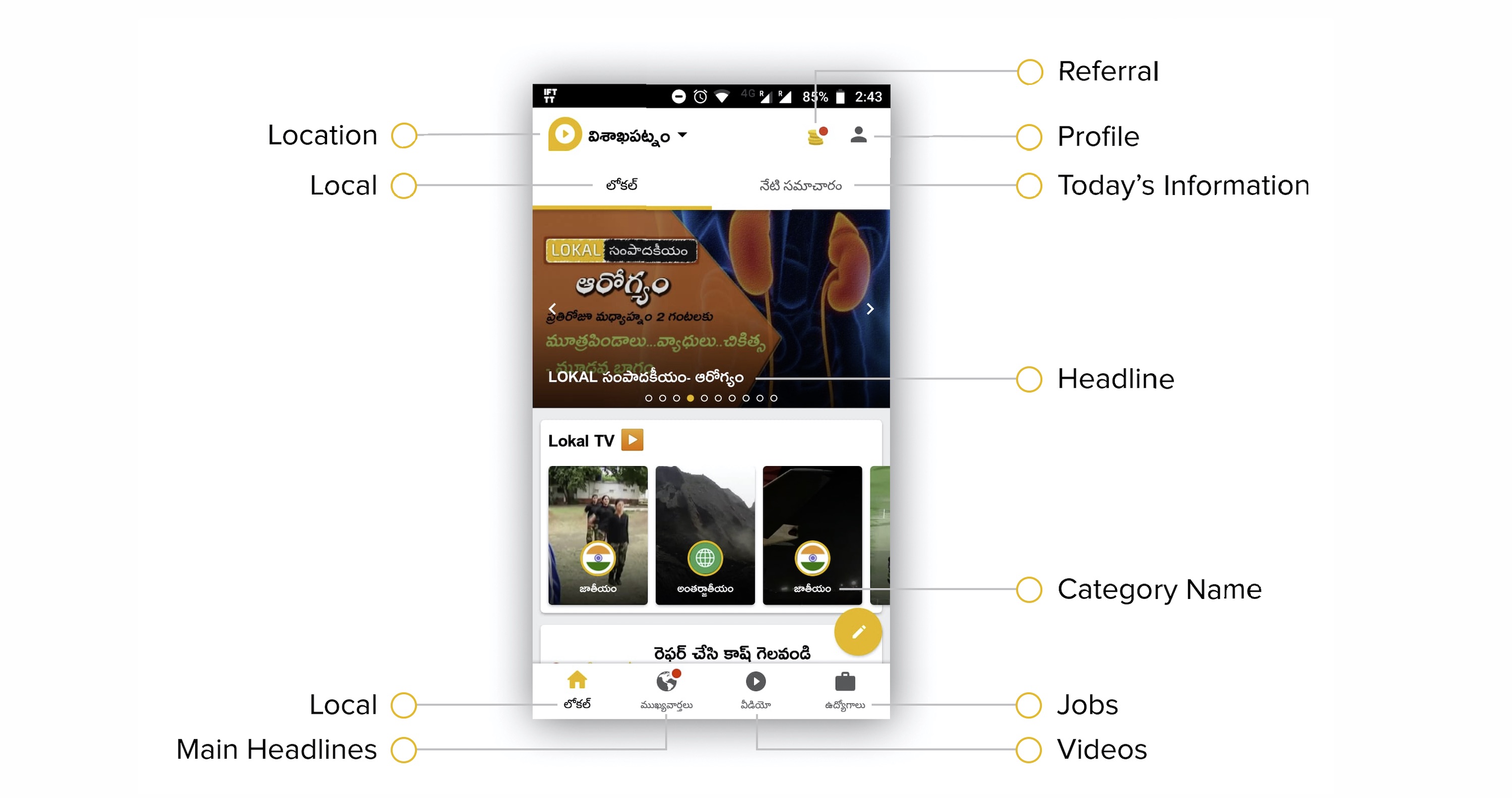
There are tens of thousands of publications in India and several news aggregators that showcase the top stories from the mainstream outlets. But very few today are focusing on local news and delivering it in a language that the masses can understand, Pasha said.
Lokal is building a network of stringers and freelance reporters who produce original reporting around the issues and current affairs of local towns and cities. The app is updated throughout the day with regional news and also includes an “information” stream that shows things like current price of vegetables, upcoming events and contact details for local doctors and police stations.
The platform has grown to cover 18 districts in South India and is slowly ramping up its operations to more corners of the country. The early signs show that people are increasingly finding Lokal useful. “In 11 of the 18 districts we cover, we already have a larger presence and reader base than other media houses,” Pasha said.
Before creating Lokal, Pasha and the other co-founder of the startup, Vipul Chaudhary, attempted to develop a news aggregator app. The app presented news events in a timeline, offering context around each development.
“We made the biggest mistake. We built the product for four to five months without ever consulting with the users. We quickly found that nobody was using it. We went back to the drawing board and started interviewing users to understand what they wanted. How they consumed news, and where they got their news from,” he said.
“One thing we learned was that most of these users in tier 2 and tier 3 India still heavily rely on newspapers. Newspapers still carry a lot of local news and they rely on stringers who produce these news pieces and source them to publications,” he added.
But newspapers have limited pages, and they are slow. So Pasha and the team tried to build a platform that addresses these two things.
Pasha tried to replicate it through distributing local news, sourced from stringers, on a WhatsApp group. “That one WhatsApp group quickly became one of many as more and more people kept joining us,” he recalls. And that led to the creation of Lokal.
Along the journey, the team found that classifieds, matrimonial ads and things like birthday wishes are still driving people to newspapers, so Lokal has brought those things to the platform.
Pasha said Lokal will expand to three more states in the coming months. It will also begin to experiment with monetization, though that is not the primary focus currently. “The plan is to eventually bring this to entire India,” he said.
A growing number of startups today are attempting to build solutions for what they call India 2 and India 3 — the users who don’t live in major cities, don’t speak English and are financially not as strong.
ShareChat, a social media platform that serves users in 15 regional languages — but not English — said recently it has raised $100 million in a round led by Twitter. The app serves more than 60 million users each month, a figure it wants to double in the next year.
Powered by WPeMatico
Is there room for another social media platform? ShareChat, a four-year-old social network in India that serves tens of million of people in regional languages, just answered that question with a $100 million financing round led by global giant Twitter .
Other than Twitter, TrustBridge Partners, and existing investors Shunwei Capital, Lightspeed Venture Partners, SAIF Capital, India Quotient and Morningside Venture Capital also participated in the Series D round of ShareChat.
The new round, which pushes ShareChat’s all-time raise to $224 million, valued the firm at about $650 million, a person familiar with the matter told TechCrunch. ShareChat declined to comment on the valuation.

Screenshot of Sharechat home page on web
“Twitter and ShareChat are aligned on the broader purpose of serving the public conversation, helping the world learn faster and solve common challenges. This investment will help ShareChat grow and provide the company’s management team access to Twitter’s executives as thought partners,” said Manish Maheshwari, managing director of Twitter India, in a prepared statement.
Twitter, like many other Silicon Valley firms, counts India as one of its key markets. And like Twitter, other Silicon Valley firms are also increasingly investing in Indian startups.
ShareChat serves 60 million users each month in 15 regional languages, Ankush Sachdeva, co-founder and CEO of the firm, told TechCrunch in an interview. The platform currently does not support English, and has no plans to change that, Sachdeva said.
That choice is what has driven users to ShareChat, he explained. In the early days of the social media platform, the firm experimented with English language. It saw most of its users choose English as their preferred language, but this also led to another interesting development: Their engagement with the app significantly reduced.
“For some reason, everyone wanted to converse in English. There was an inherent bias to pick English even when they did not know it.” (Only about 10% of India’s 1.3 billion people speak English. Hindi, a regional language, on the other hand, is spoken by about half a billion people, according to official government figures.)
So ShareChat pulled support for English. Today, an average user spends 22 minutes on the app each day, Sachdeva said. The learning in the early days to remove English is just one of the many things that has shaped ShareChat to what it is today and led to its growth.
In 2014, Sachdeva and two of his friends — Bhanu Singh and Farid Ahsan, all of whom met at the prestigious institute IIT Kanpur — got the idea of building a debate platform by looking at the kind of discussions people were having on Facebook groups.
They identified that cricket and movie stars were popular conversation topics, so they created WhatsApp groups and aggressively posted links to those groups on Facebook to attract users.
It was then when they built chatbots to allow users to discover different genres of jokes, recommendations for phones and food recipes, among other things. But they soon realized that users weren’t interested in most of such offerings.
“Nobody cared about our smartphone recommendations. All they wanted was to download wallpapers, ringtones, copy jokes and move on. They just wanted content.”

So in 2015, Sachdeva and company moved on from chatbots and created an app where users can easily produce, discover and share content in the languages they understand. (Today, user generated content is one of the key attractions of the platform, with about 15% of its user base actively producing content.)
A year later, ShareChat, like tens of thousands of other businesses, was in for a pleasant surprise. India’s richest man, Mukesh Ambani, launched his new telecom network Reliance Jio, which offered users access to the bulk of data at little to no charge for an extended period of time.
This immediately changed the way millions of people in the country, who once cared about each megabyte they consumed online, interacted with the internet. On ShareChat people quickly started to move from sharing jokes and other messages in text format to images and then videos.
That momentum continues to today. ShareChat now plans to give users more incentive — including money — and tools to produce content on the platform to drive engagement. “There remains a huge hunger for content in vernacular languages,” Sachdeva said.
Speaking of money, ShareChat has experimented with ads on the app and its site, but revenue generation isn’t currently its primary focus, Sachdeva said. “We’re in the Series D now so there is obviously an obligation we have to our investors to make money. But we all believe that we need to focus on growth at this stage,” he said.
ShareChat also has many users in Bangladesh, Nepal and the Middle East, where many users speak Indian regional languages. But the startup currently plans to focus largely on expanding its user base in India.
It will use the new capital to strengthen the technology infrastructure and hire more tech talent. Sachdeva said ShareChat is looking to open an office in San Francisco to hire local engineers there.
A handful of local and global giants have emerged in India in recent years to cater to people in small cities and villages, who are just getting online. Pratilipi, a storytelling platform has amassed more than 5 million users, for instance. It recently raised $15 million to expand its user base and help users strike deals with content studios.
Perhaps no other app poses a bigger challenge to ShareChat than TikTok, an app where users share short-form videos. TikTok, owned by one of the world’s most valued startups, has over 120 million users in India and sees content in many Indian languages.
But the app — with its ever growing ambitions — also tends to land itself in hot water in India every few weeks. In all sensitive corners of the country. On that front, ShareChat has an advantage. Over the years, it has emerged as an outlier in the country that has strongly supported proposed laws by the Indian government that seek to make social apps more accountable for content that circulates on their platforms.
Powered by WPeMatico
The right people to solve the trillion-dollar student debt crisis might be the ones who are suffering from it the hardest.
If you’re a recent college graduate, there’s a 50% chance you took on debt when you moved off campus. If you’re like the average student borrower, you graduated with $29,800 of loan debt, and are making a monthly re-payment of between $200 and $300, according to a recent report from the New York Fed.
GradJoy is a new Y Combinator-backed startup that wants to help the 45 million student debt borrowers in the U.S. manage their repayment plans. Within seven days of being a live platform and a marketing strategy that consisted of reaching out to a few universities, GradJoy is already managing $20 million in loans.
Co-founders Jose Bethancourt and Marco del Carmen turned down roles at Cloudflare and MongoDB, respectively, upon learning they’d been accepted to Y Combinator’s Summer 2019 class. GradJoy bills itself as a “student loan co-pilot,” and currently exists as a platform that helps users manage student loan repayments — whether that’s assessing pros and cons of refinancing, what a monthly payment should look like and if they have any wiggle room based on greater income and spending habits. GradJoy hopes to hammer a few cracks in the $1.5 trillion federal student loan debt crisis by giving new borrowers more insight into their repayment journey.
Loan companies will always advise borrowers to pay the minimum because they benefit from the outrageous interest fees amassed over time. GradJoy wants to tap into your bank account and monitor your finances to deliver more transparent loan-management advice with a feature that lets you simulate how different payment amounts would affect your loans.
Bethancourt, a recent University of Texas graduate, was his own first user. He built the GradJoy platform for himself while calculating his optimal student loan repayment plan in Excel. He’d met his co-founder in a coding bootcamp in the Rio Grande Valley at the border of Mexico and South Texas — where Bethancourt is originally from.

Jose Bethancourt (Left) Marco del Carmen (Right)
Student lending is a predatory industry that benefits off the ignorance of first-time borrowers and has been known to purposefully constrict resources for customers. New borrowers must navigate landmines like refinancing scams, the “7-minute rule” for customer service assistance and tricky requirements buried within the public service loan forgiveness program.
A question is posed for new startups that want to punch up against greedy student loan servicers like Navient and AES. Without replicating the corrupt business models that lenders have in order to make money off the student loan debt problem, how can newcomers like GradJoy become profitable?
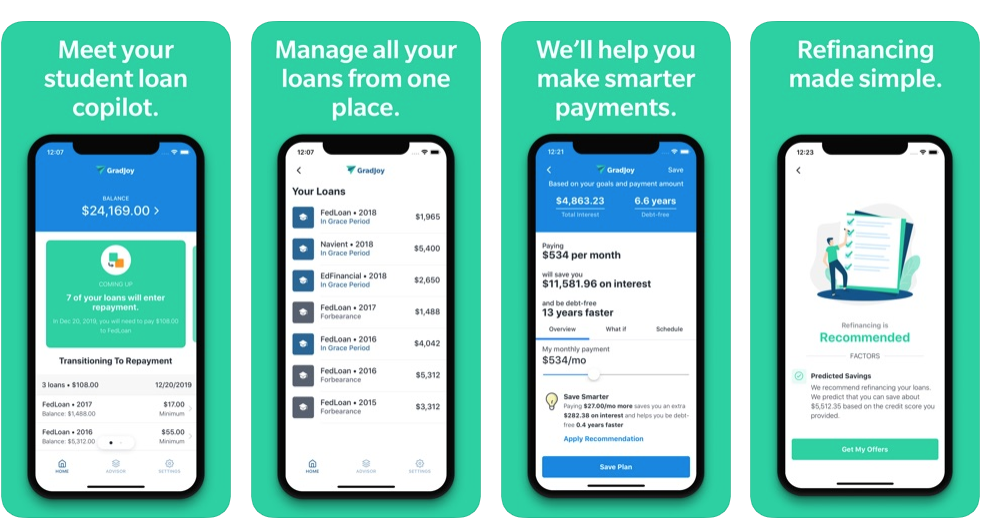
Gradjoy bills itself as a “student loan co-pilot”
Aside from venture capital, which GradJoy will be seeking upon its graduation from Y Combinator, it will make money in a few ways. In order to align with users’ goals, GradJoy’s business model is tied to their savings. If a user refinances using GradJoy, they get a referral payment from their lending partners. The platform is currently beta testing their robo-advisor for debt, and in the future they plan on charging a small fee per month if they’re able to save a user money.
Student loans don’t only burden millennial bank accounts. The student loan debt crisis is creating an economic trend. Inability to repay student loans causes young people to rely on credit cards to make ends meet and delay major life choices like investing in property. Not to mention the affect of student debt on mental health for young people at an already volatile point in their lives.
In five years, GradJoy’s founders say they’d like to be running a more robust financial services product that was first focused on helping its customers pay off student loans. They hope to mobilize customers while they’re at the nascence of their financial independence, and scale up to launch a larger suite of financial service products.
Powered by WPeMatico